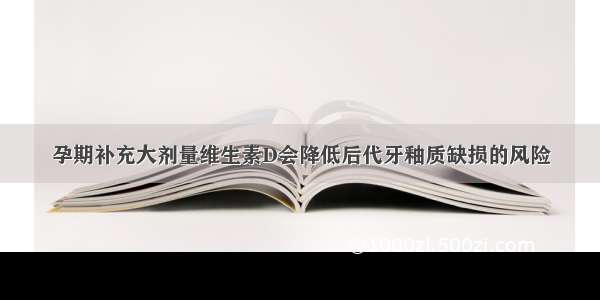
关注“奥维抗病营养”
掌握更多专业知识和市场行情
导 读牙釉质,是牙冠外层的白色半透明的钙化程度最高的坚硬组织。牙釉质内部并不具神经与血管。它的功用除了咬碎食物之外,也可以保护下层的牙本质,是人体中最坚硬的物质。它保护着牙齿内部的牙本质和牙髓组织。下图即为:牙釉质缺损。
文Id献
原名:Association of High-Dose Vitamin D Supplementation During Pregnancy With the Risk of Enamel Defects in Offspring: A 6-Year Follow-up of a Randomized Clinical Trial.
译名:孕期补充大剂量维生素D与后代牙釉质缺损的风险研究:一项随机临床试验的6年随访
作者:Nørrisgaard PE
期刊:JAMA Pediatr
IF:12.004
发表日期:.8.5
PMID:31381020
译 文
重要性
发育性牙釉质缺损会影响高达38%的学龄儿童,是被公认的全球公共卫生健康挑战。由于过敏症,后遗症,快速龋齿的发展,牙釉质缺损会导致导致疼痛,在某些情况下只能拔除。其病因尚不清楚,因此目前尚不可能预防。
目的
评估补充高剂量维生素D对怀孕妇女牙釉质缺损和龋齿的影响。
试验设计、设置和参加人员
在,哥本哈根儿童哮喘前瞻性研究团队(COPSAC,),采用双盲、单中心、随机临床试验后方案分析。3月开始试验,包括招募怀孕24周时的623名妇女及其588名子女。588名儿童中有496名在6岁时完成了牙科检查(84%)。对数据进行了分析。
处理
妇女志愿者从怀孕24周至产后1周服用高剂量维生素D3(2400 IU/D;N=315)或匹配的安慰剂片剂(N=308)。此外,所有妇女都接受了400 IU/D的维生素D3作为标准护理的一部分。
方法
牙釉质缺损被定义为至少有1个磨牙受到划界混浊、釉质破裂和/或不典型修复的影响。龋病被定义为乳牙和恒牙的腐烂、缺失或充填表面(世界卫生组织标准)。
结果
妊娠期服用高剂量维生素D的母亲后代患牙釉质缺损的风险低于标准剂量(15.1%[n = 26]vs 27.5%[n = 44];降低比例0.47;95%CI,0.27~0.81)。乳牙期也有类似的发现(8.6%[n = 21,2 4 4]vs 15.9%[n = 4 0];降低比例0.5;95%CI,0.2 8~0.87)。补充与龋齿之间没有关联。
结论
怀孕期间补充大剂量维生素D可以降低后代牙釉质缺陷的几率,约50%。这表明产前维生素D补充剂作为牙釉质缺陷的预防性干预,与牙齿健康有临床重要联系。
原 文
Importance
Enamel defects of developmental origin affect up to 38% of schoolchildren and is recognized as a global public health challenge. The impaired enamel formation results in pain owing to hypersensitivity, posteruptive breakdowns, rapid caries progression, and extractions in some cases. The etiology is unknown; therefore, prevention is currently not possible.
Objective
To assess the association of a high-dose vitamin D supplementation in pregnant women with enamel defects and caries in their offspring.
Design, Setting, and Participants
Post hoc analysis of a double-blind, single-center, randomized clinical trial, the Copenhagen Prospective Studies on Asthma in Childhood cohort (COPSAC). Enrollment began March and included 623 women recruited at 24 weeks of pregnancy and 588 of their children. A dental examination was completed at age 6 years in 496 of 588 children (84%). Data were analyzed in .
Intervention
High-dose vitamin D3 (2400 IU/d; N = 315) or matching placebo tablets (N = 308) from pregnancy week 24 to 1 week post partum. In addition, all women received 400 IU/d of vitamin D3 as part of standard care.
Main Outcomes and Measures
Enamel defect was defined as having at least 1 molar affected by demarcated opacity, enamel breakdown, and/or atypical restoration. Caries was defined as decayed, missing, or filled surfaces in both the deciduous and permanent dentitions (World Health Organization standard).
Results
The risk of enamel defects in the permanent dentition was lower in the offspring of mothers who received high-dose vitamin D supplementation during pregnancy compared with standard dose (15.1% [n = 26 of 172] vs 27.5% [n = 44 of 160]; odds ratio, 0.47; 95% CI, 0.27-0.81). A similar association was observed for the deciduous dentition (8.6% [n = 21 of 244] vs 15.9% [n = 40 of 252]; odds ratio, 0.50; 95% CI, 0.28-0.87). There was no association between supplementation and caries.
Conclusions and Relevance
High-dose vitamin D supplementation during pregnancy was associated with approximately 50% reduced odds of enamel defects in the offspring. This suggests prenatal vitamin D supplementation as a preventive intervention for enamel defects, with a clinically important association with dental health.
部分图文源于网络,如有侵权,立即删除。▼往期精彩回顾▼研究:维生素D水平与特定种族的心脏代谢特征有关最新研究:维生素A摄入量与皮肤鳞状细胞癌风险的关系维生素E对受到力竭运动小鼠的影响















